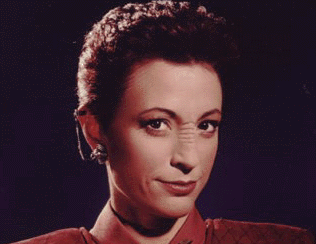Biographical Data:Psycho-Medical Profile:
Report of DS9 Chief Medical Officer Julian Bashir, M.D.
Though Kira
has always possessed the tactical and strategic skills to do her job exceptionally
well, it is in interpersonal communication, self-assurance, and finding
the imagination extinguished by a refugee's atrophied childhood where
she has grown the most since this officer first encountered her in 2369.
Having lived on the edge of life and death for so long, Kira's
emotions are always close to the surface and they can be unusually strong:
love, grief and anger being the most prevalent. She has also slowly
come to grips with both the violence of her past actions and her strong
anti-Cardassian disposition.
Young Kira
Nerys faced the same terrifying and brutal life faced by many of her Bajoran
brethren: her father, a farmer or gardener by trade, was killed fighting
in the resistance while her mother, an icon painter, died of malnutrition
in the Singha Refugee Camp when Nerys was 3. She had at least two
brothers and apparently no sisters; all they had to play in the camp growing
up was Bajoran springball, but she had some crafts such as finger-painting
at age 4 in the camp school. Having forsworn any artistic aptitude,
she ironically would have been a member of the artist J'barra of Ih'valla,
had the ancient Bajoran caste system survived the Occupation. At the age
of only 12, after working in the mines, the orphaned Kira was recruited
by Lorit Akrem into the province's Shakaar resistance cell, named for
its leader. A year later, after running errands and cleaning weapons,
the group finally accepted her fully when Shakaar approved her replacing
a missing member for a raid on a Cardassian skimmer.
The earring
she wears today was made from the metal of the skimmer by cellmate Lupaza,
after Kira killed the entire unloading complement while giddily trying
to impress the group. A year later she helped to temporarily liberate
the Cardassians' notorious Gallitepp labor camp, and eventually learned
to fly outdated Raider craft against her oppressors. She suffered
during the winter of 2360-61 along with the rest of her cell in her native
Dahkur Hills caves, unarmed and hungry; her group evaded Cardassians for
10 years in the area. Through it all Kira never served time in Cardassian
prison, but she was once rescued from a Cardassian interrogation center
with her fellow cellmates.
Her war for
Bajor's liberation had to include murder as well, such as when she helped
plasma-bomb the home of Gul Pirak in Hathon, and when she checked aboard
the Terok Nor station in 2365 to kill a native collaborator with the Cardassians;
the latter took a toll on her soul no amount of eventual victory could
erase. Ironically, she met Odo and Quark for the first time on
that mission and was almost caught, the truth not coming to light until
years later as the station's post-withdrawal first officer. She accepted
a major's commission and the post as Bajoran military attaché to Ben Sisko
and the Starfleet administrators on DS9 following the withdrawal in 2369
- although she had initially turned it down and opposed the Bajoran provisional
government's move to invite Starfleet in.
As she and
Sisko grew to work and trust each other while respecting their own agendas,
she was temporarily recalled early the next year pending reassignment
during the abortive coup on Bajor, just after she risked life and career
to rescue reluctant Bajoran hero Li Nalas. It was then when she
first truly met Vedek Bareil, then the front-runner to replace Kai Opaka,
and they fell in love. Despite the coming of Bajoran independence, grief
would continue to be a constant for Kira.
It was she
who performed the Bajoran death ritual for Opaka soon after, when the
kai was trapped in virtual death in the Gamma Quadrant. The next
year Kira was at Bareil's side when a scandal in a no-win scenario during
the occupation dashed his chances to become Kai; a year later she faced
his death alone on the eve of his Cardassian peace treaty that Winn would
later take the credit for. But Kira had some solace, blocking Winn's
drive to be secular leader of Bajor as well when she helped diffuse a
crisis and bolster her old resistance leader Shakaar to the post instead.
She in turn fell in love with him a year later, lending no less a figure
than Gul Dukat to note her obvious attachment to strong male personalities.
In addition, Kira was also attracted to Tom Riker despite her involvement
with Bareil; after his theft of the U.S.S. Defiant, she eventually talked
him into taking Dukat and Sisko's deal of surrender with a rare Cardassian
prison term that she vows she'll help him escape from some day. Because
of her initial thin-skinned reputation, Kira has had to convince Sisko
she can handle cases close to her heart and has a hard time dealing with
the fact that she can't always fight for the underdog anymore.
Her hatred
of Cardassians tempered much faster than even she would have thought,
sympathizing with the amazing case of Aamin Marritza and even becoming
allies with her hated Gul Dukat on occasion, saving his half-Bajoran daughter
from Dukat's own hand to avoid the shame and later taking her in to save
her from a rogue marauder's life with him. Even more so, she abhors
Quark and all Ferengis, and is an infrequent visitor to his bar.
She feels that "Starfleet types" live too much by automation
and not enough by their wits, and still thinks the Federation itself is
"naive" - but her Cardassian experience has left her a strong
civil libertarian, opposed to unnecessary security crackdowns. Though
not overtly religious initially, she supported Winn as a "true believer"
until her treachery, once revealed, left her shaken and even more an admirer
of Sisko's character - despite never having been comfortable with working
under the "Emissary." Although she came to have more faith
and meditates daily in her quarters, she never sees the prophets' will
as Winn does.
Her Spartan
quarters feature a personal Bajoran shrine - the standard icon behind
an altar - with a couch and endtable, a desk, and a table with two chairs
in her living room. Kira was kidnapped in 2371 and surgically altered
to be Cardassian as a pawn in an elaborate Obsidian Order plot to expose
her alter ego's father, a powerful legate, as a Cardassian dissident;
after his rescue they formed an odd bond. Later that year she was
chosen as Presider for DS9's Gratitude Festival shortly before Bariel's
sudden death and had planned to spend the holiday with him but fell for
Bashir instead, thanks to Lwaxana Troi's Zanthi fever - which only acts
in case of latent relationships. Kira stays fit and trim thanks to her
lifelong affinity for Bajoran springball: aside from following the local
teams' standings she allows it as a rare personal holo-program diversion.
Because she feels ill at ease with idle time and her rough childhood allowed
little room for fantasy, she usually hates holosuites as a waste of time
and prefers instead the real thing - a trait Dax is trying to help change;
despite that spare outlook, she does use feminine toiletries like epidellic
skin lotion. In music, she only knows Bajoran composers and doesn't
feel artistic at all despite her mother's career - an irony of Akorem
Lann's short-lived return to the d'jarra family castes. At times
she has enjoyed Bajoran synthale, a Stardrifter, Bajoran ginger tea, and
hot coffee. She's never won anything before Quark's "prizes,"
but does know how to play Dabo.
Psycho-Medical
Profile:
UPDATE Stardate 50500: CMO Julian Bashir recording
Since the
last posting in the file, I have followed the effects of two major events
on subject Kira's life: her ongoing interaction with Gul Dukat, and her
serving as surrogate mother for the O'Brien's unborn child. The trip with
Dukat early in 2372 to uncover the missing Bajoran prison ship Ravinok
set in motion a host of events for Kira. While finally ascertaining
the death of her fellow Shakaar cellmate Lorit, her insistence that Dukat
let his illegitimate daughter Ziyal survive cost him his standing and
he subsequently became a marauder against the invading Klingons.
In turn, Kira argued to let Ziyal remain at the station, untouched by
the chaos and under her wing.
The entire
episode also revealed Dukat's affection for her -- a move which Kira has
confessed she easily dismissed, even though the cross-cultural emotions
between two former avowed enemies troubled her. More importantly, the
emergency transporter transplant I performed to save the O'Brien fetus
when Keiko was injured has had all kinds of repercussions since I determined
Kira would have to carry the baby to term, due to Bajoran fetal differences.
Asking her to move in with them was a good pre-natal move by the O'Briens
for all concerned, but I suspect the baby's birth finally allowed the
Chief to relax over everything from his concern over her raktajino caffeine
intake to this doctor's sneaking suspicion of a latent attraction between
he and the major at one point.
Having the
baby according to the traditional Bajoran relaxation process I believe
eased her port-partum syndrome, if anything could have helped that; her
reaction in this vein will be monitored. Kira reported the typical Bajoran
symptoms of sneezing, muscle spasms and swollen feet, and despite her
distaste for makara herbs she owes her life to them now since they inhibited
her system from a kidnapper's poison serum injections. (I thought
I had seen the end of the short-fused Kira until this latter episode,
when she took off after the presumed stalker of her old resistance cell
mates.) As a sidelight, it also appears that both Kira and Sisko are becoming
more comfortable with his role as Emissary and as station commander especially
since the coming and going of his pagh'tem'far visions. On the other
hand, she has admitted to me her longtime trust in Odo was truly shaken
by his recent revelation of a rush to justice in 2366 in helping execute
three innocent Bajorans on Terok Nor during the occupation - a highly
atypical scenario for the constable.
|










